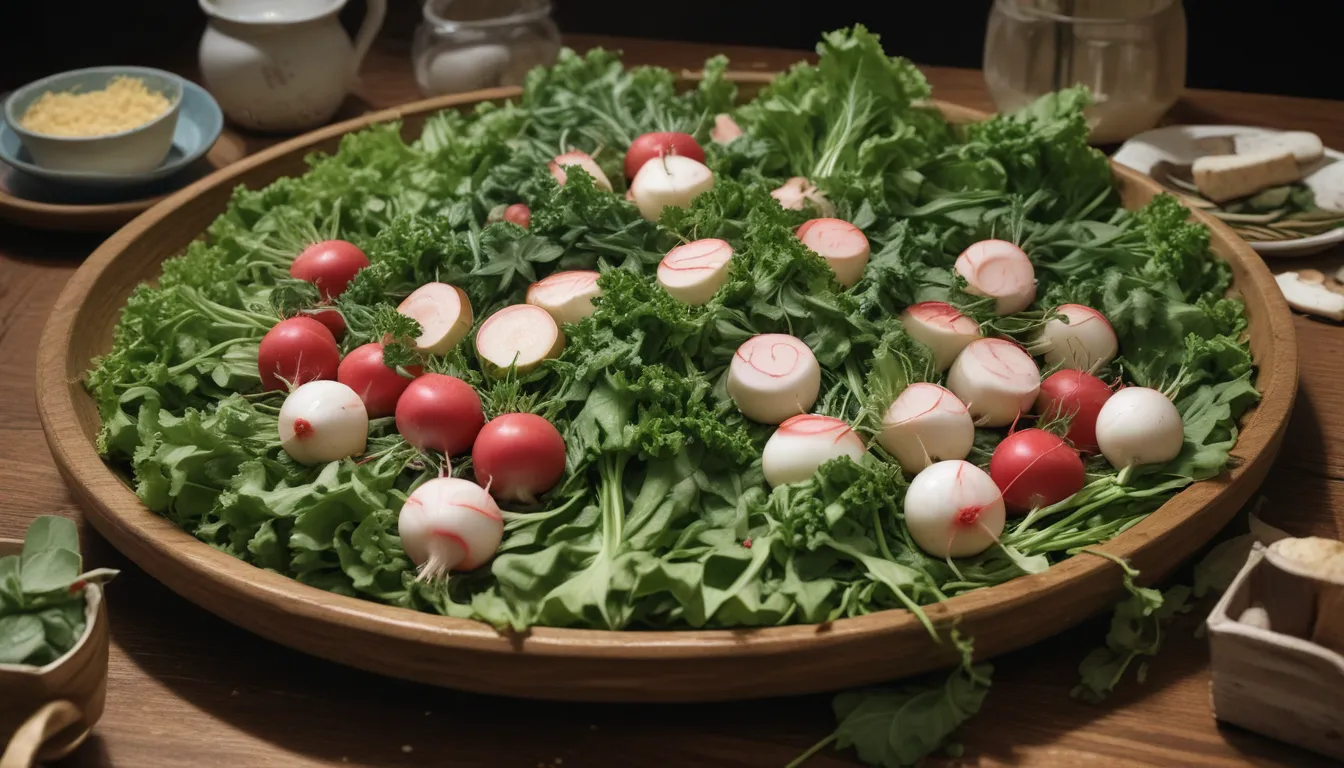Everything You Need to Know About Eating Radish Greens

Are you a radish lover? Did you know that you could be missing out on a tasty opportunity to enjoy homegrown leafy greens? Radishes, those trusty spring and fall vegetables, produce edible leaves along with their crispy, spicy roots.
Whether you’re adding them to your salads or stir-fries or just munching on them as sprouts or microgreens, radish greens are a versatile and nutritious addition to your culinary repertoire.
In this comprehensive guide, we’ll explore everything you need to know about eating radish greens. From how and when to harvest them to creative cooking ideas, we’ve got you covered. So let’s dig in and discover the delicious world of radish greens together!
Are Radish Greens Edible?
If you’ve never considered eating radish greens before, it’s time to take a closer look. Radish tops resemble other leafy greens you might be familiar with, such as mustard or turnip greens, and they offer a similar earthy and slightly spicy flavor profile.
Spring-sown radishes produce roots that mature in 21 to 35 days, with their greens being edible at every stage of growth. However, for the best taste, it’s recommended to harvest them before they develop a hot flavor due to aging or heat exposure.
Spring varieties produce microgreens and baby leaves perfect for salads or cooking, while winter radish greens are only tasty and tender for the first 30 days or until they reach five or six inches tall.
To ensure you’re harvesting the best-tasting greens, it’s essential to provide adequate water, weed control, and choose varieties that mature before the onset of hot weather.
Whether you’re growing fast-growing radishes suitable for root and top harvest or varieties that take months to mature, there’s a delicious opportunity to enjoy radish greens throughout their growing cycle.
How and When to Harvest Radish Greens
Depending on your preferred eating style, radish greens can be harvested at various stages of growth. Here’s a breakdown of how and when to harvest radish greens based on their development:
Sprouts
Radish seeds are a popular choice for sprouting, offering a quick and nutritious snack in just three to four days. To sprout radish seeds, simply soak them overnight in a covered container, rinse, and drain daily until they sprout.
Once the sprouts have developed their first set of cotyledons and reached about an inch in length, they’re ready to eat. Sprouts can be stored in an airtight container for up to a week and used in salads, sandwiches, or as a garnish.
Microgreens
If you’re planning to harvest radishes as microgreens, you’ll want to cut the young greens just after they form their first set of true leaves, usually at one and a half to two inches tall. Microgreens can be cut at the soil line and stored in an airtight container for up to five days.
These zesty greens are perfect for adding a pop of flavor and color to salads, sandwiches, or soups. Just make sure to wash them before serving and dry them thoroughly to avoid sogginess.
Baby Leaves
For a more substantial green harvest, consider picking the baby leaves just as the radish roots start to form. Aim for leaves with at least two sets of true leaves and a height of one and a half inches to four inches for the best texture and flavor.
Tender and mildly spicy, baby leaves can be used in salads, stir-fries, or smoothies. Keep in mind that larger leaves tend to become tougher and more pungent, so harvest them at the optimal size for the most enjoyable culinary experience.
By following these guidelines for harvesting radish greens, you can enjoy fresh and flavorful greens throughout the growing season.
Cooking Ideas for Radish Greens
From snacking on microgreens straight from the garden to incorporating baby leaves into a delicious green smoothie, there are countless ways to enjoy radish greens in your culinary creations. Here are some creative cooking ideas to inspire your next meal:
- Add radish sprouts to salads or sandwiches for a zesty crunch.
- Use microgreens as a garnish for soups, stews, or pizza.
- Substitute baby leaves for kale or collards in your favorite recipes for a spicy twist.
- Try sautéing radish roots and greens together for a quick and flavorful side dish.
Whether you’re a seasoned cook or a novice gardener, radish greens offer a versatile and nutritious addition to your kitchen repertoire. Experiment with different flavors and textures to discover new ways to enjoy these tasty greens.
Conclusion
In conclusion, radish greens are a delicious and nutritious addition to your culinary creations. Whether you’re harvesting sprouts, microgreens, or baby leaves, there’s a world of flavor waiting to be explored in your garden.
By following the tips and guidelines outlined in this guide, you can enjoy fresh and flavorful radish greens throughout the growing season. So next time you’re in the garden, don’t forget to pick a few fresh leaves of Raphanus sativus to add a tasty twist to your meals.
Have you tried cooking with radish greens before? Share your experiences and recipe ideas in the comments below. And if you found this guide helpful, be sure to check out our other radish-related articles for more tips and inspiration!
Happy gardening and happy eating!





